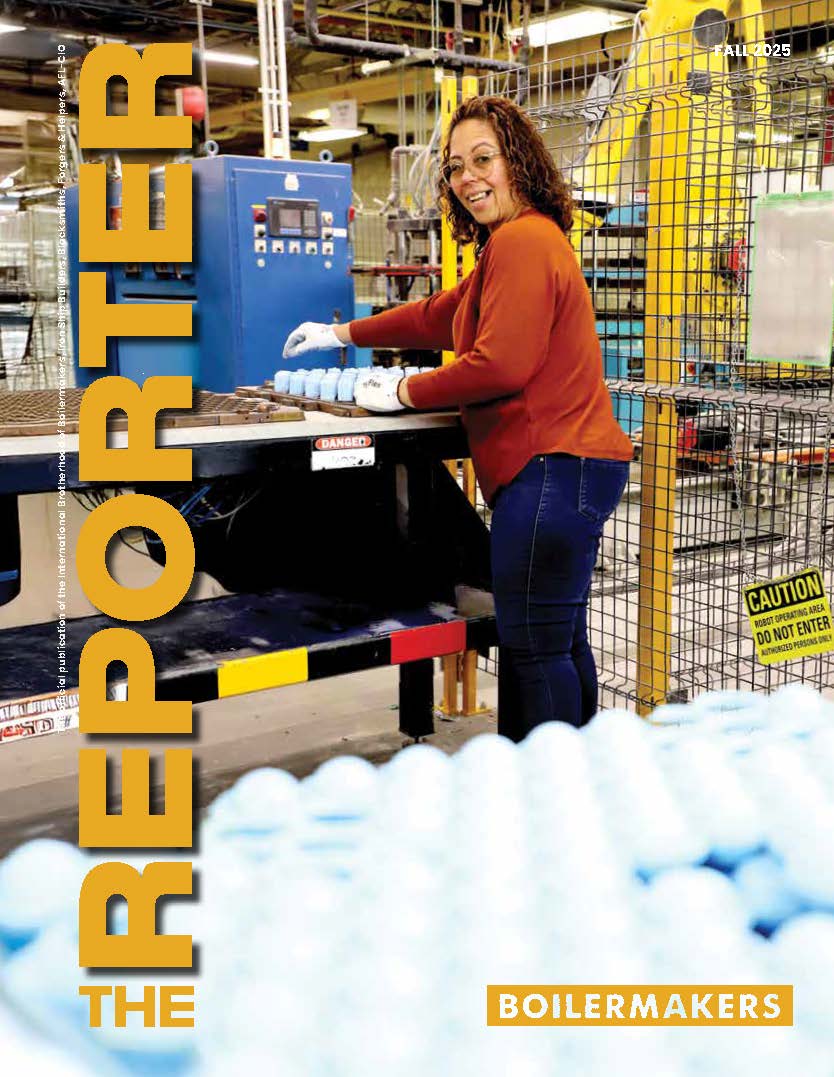CCS technology is proven, it’s continually improving and now it can be done much cheaper too. As global citizens concerned about sustainability and climate, we need action more than just conversations about CCS. And when the Boilermakers come in, it’s not just talk. These guys—the Boilermakers—are ready to do it.
Attendees view the Boilermakers commissioned film “CCS: Bridge to a Cleaner Energy Future” to learn how CCUS works and why it is a vital climate-change solution that preserves jobs and the economy.
View Photo Gallery (7 photos)
BOILERMAKERS CHAMPIONED CARBON Capture, Use and Storage (CCUS) technology at two key energy and climate events in Saskatchewan and British Columbia in May. The Boilermakers union partnered with Saskatchewan Building Trades to host a town hall on CCUS in Estevan, Saskatchewan, and participated in a panel discussion with the International CCS Knowledge Centre during the global CEM10/MI-4 conference in Vancouver.
“Climate change isn’t just a problem regionally or locally,” said Boilermakers International Director for Climate Change Policy Solutions, Cory Channon, who spearheaded the Boilermakers’ involvement in the events. “This is a global problem, and the Boilermakers are a part of the global solution.”
The CCUS Town Hall in Estevan brought in leaders from the Global CCS Institute and International CCS Knowledge Centre on May 23 to share the latest information on CCUS, provide updates on costs and technology and advocate for local opportunities for additional CCUS projects. Estevan has much at stake concerning the future of CCUS: Coal mining is among the largest employers in the town, which is also home to the Shand and Boundary Dam coal-fired power stations. Further, the Boundary Dam station is SaskPower’s largest coal-fired station and was the first of its kind to have one of its units retrofit for CCUS technology.
“This is very important to us in our community,” said Estevan Mayor Roy Ludwig, who works at the Westmoreland Coal Company’s Estevan mines and is a member of the UMW. “I’ve had the privilege to work in a coal mine, and I’m sure all my brothers and sisters will attest that these are great paying jobs and we’d like to keep them going in the community. We want to continue to expand the clean coal technology we’re so proud of, and we’re going to continue to push for it.”
Town hall attendees included trade union members from the Boilermakers, IBEW and United Mine Workers, among other trades; provincial media; provincial-level Member of the Legislative Assembly Lori Carr; and three prominent federal-level leaders, conservative Members of Parliament Robert Kitchen (Saskatchewan), John Barlow (Alberta) and Ed Fast (British Columbia).
“This is a global challenge that requires a global response,” said MP Ed Fast. “I’m so pleased to see the Boilermakers and other trades here.”
Discussions centered around the technology as well as the potential for another CCUS project—either retrofitting another Boundary Dam unit due for retirement or building a CCUS unit at nearby Shand Power Station. Nationwide, Canada has called for a federal coal phase-out and the shuttering of all coal-fired plants by 2030—unless they are retrofitted with CCUS.
In order to meet the IPCC targets and reduce emissions to net-zero by mid-century in an effort to prevent dangerous climate changes, we need all solutions to be deployed as soon as possible, including renewables, hydro, nuclear and carbon capture and storage.
“It all comes down to politics and economics,” Ludwig said.
Those arguing against CCUS often focus on the technology’s price.
Robert Mitchell, Senior Client Engagement Lead with the Global CCS Institute noted that as with any new, first-generation technology, costs for CCUS have decreased and will further decrease as the technology scales up, while at the same time, technology improvements continue to develop. He said there are now 43 CCUS projects in operation, under construction or in development around the world, and that many more are needed—along with all other climate-change solutions—to meet the Paris Agreement targets on climate change.
“What you’ve done here [in bringing CCUS to the Boundary Dam station] is spur the next generation [of CCUS technology], which will spur the next generation,” he said. “We need that; and, in order to meet the IPCC targets and reduce emissions to net-zero by mid-century in an effort to prevent dangerous climate changes, we need all solutions to be deployed as soon as possible, including renewables, hydro, nuclear and carbon capture and storage.”
“If you object to CCUS technology, then you object to the United Nations’ Intergovernmental Panel on Climate Change report. And that means you are disagreeing with some of the brightest scientists on the planet, who are saying that carbon capture is the pathway to correct the carbon dioxide emissions we are currently throwing into the air globally,” Channon reminded the crowd after sharing the Boilermaker-commissioned film “CCS: Bridge to a Cleaner Energy Future.”
MP Robert Kitchen lauded the Boilermakers’ advocacy of CCUS. “It’s great to see the Boilermakers putting up this video. That’s the kind of thing we need people to do.”
Added Dion Malakoff, executive director of Saskatchewan Building Trades and a member of Local 555 (Winnipeg, Manitoba), “We need people to understand how this technology works. We need to debunk the myths.”
“CCS: Bridge to a Cleaner Energy Future” was also featured during a special screening at the CEM10/M1-4 conference in Vancouver. The International CCS Knowledge Centre hosted the film in its conference event space.
CEM10/M1-4 is the Clean Energy Ministerial, a high-level global forum that promotes policies and programs to advance clean energy technology, coupled with Mission Innovation, a global initiative of 23 countries and the European Commission working together to accelerate clean energy innovation and address climate change. The conference brings together the most prominent leaders in government, private sector and international organizations to promote progress toward a clean energy future.
In addition to the film screening, the Boilermakers served on a panel discussion on CCUS co-hosted and moderated by both the Knowledge Centre's President and CEO Mike Monea and ClearPath’s CEO, Rich Powell. This was also held in the Knowledge Centre’s event space. Director of Government Affairs Cecile Conroy represented the Boilermakers on the panel, joining Michal Kurtyka, Poland’s Minister of Energy and Environment and COP24 President; Steve Winberg, the U.S. Department of Energy’s Associate Secretary for Fossil Energy; Tim Thomas, Mitsubishi’s Vice President of Heavy Industries; Hang Wang, Deputy Director-General of the Agenda 21 Administrative Centre, Ministry of Science and Technology, China; Mechthild Wörsdörfer, Director of Sustainability, Technology and Outlooks for the International Energy Agency, France; and, Richard Jackson, President of Occidental Low Carbon Ventures and SVP of Operations.
Amid discussions about CCUS technology, costs, different applications for CCUS (such as in manufacturing) and timelines for continued development and scale-up, Conroy was specifically asked to address the impact of CCUS on jobs and the economy.
“The Boilermakers have spent decades modernizing the power sector with effective pollution controls, and we see CCUS as the natural progression of that for the future of our craft,” she said. “CCUS is a win-win for jobs and the environment. This is a global issue, and CCUS is a solution, not just to preserve jobs and our communities, but to truly ensure our planet survives.”
“CCS technology is proven, it’s continually improving and now it can be done much cheaper too,” said Monea. “As global citizens concerned about sustainability and climate, we need action more than just conversations about CCS. And when the Boilermakers come in, it’s not just talk. These guys—the Boilermakers—are ready to do it.”
Boundary Dam CCUS retrofit paves way for next generation technology
THE BOUNDARY DAM power station, just outside Estevan in Southeast Saskatchewan, is SaskPower’s largest coal-fired station, originally built in the early 1970s.
As the station’s six-units have approached the end of their life cycles, Units 1 and 2 were retired. Unit 3, however, proved the perfect opportunity to pilot CCUS technology. And the perfect people to work on the retrofit job: Boilermakers. About 5 million man-hours went into the work, as well as a $1.5 billion price tag, which included the extension of the life of Boundary Dam Unit 3 as well as the addition of the capture facility and CO2 pipelining to transport and storage infrastructure.
As discussions about scaling up CCUS around the world heat up, the cost was arguably a solid investment in first-generation technology from which future projects will benefit.
“It’s critical,” said Beth Hardy, Vice President of Strategy and Stakeholder Relations of the International CCS Knowledge Centre, headquartered in nearby Regina. “We can now take the model of Boundary Dam and reduce the costs for future projects (currently estimated at a 67 percent reduction in cost). And we can now look for other ways to drive future opportunities—such as putting this technology on other things, like cement plants or an iron or steel plant.”
As an early adopter of CCUS, Boundary Dam is a draw for energy and industrial companies and leaders from around the world to tour as the explore the possibilities of CCUS technology.
SaskPower, which also owns the full fleet of power stations in the province, is considering a possible CCUS on one of its 300 MW units. Based on a recent second- generation CCS feasibility study, the neighboring Shand coal-fired power station is one of the candidates for the retrofit. With effectively double the total emissions of Boundary Dam Unit 3, a 90% capture plant on a 300MW unit would have a capture capacity of 2Mt per year.













